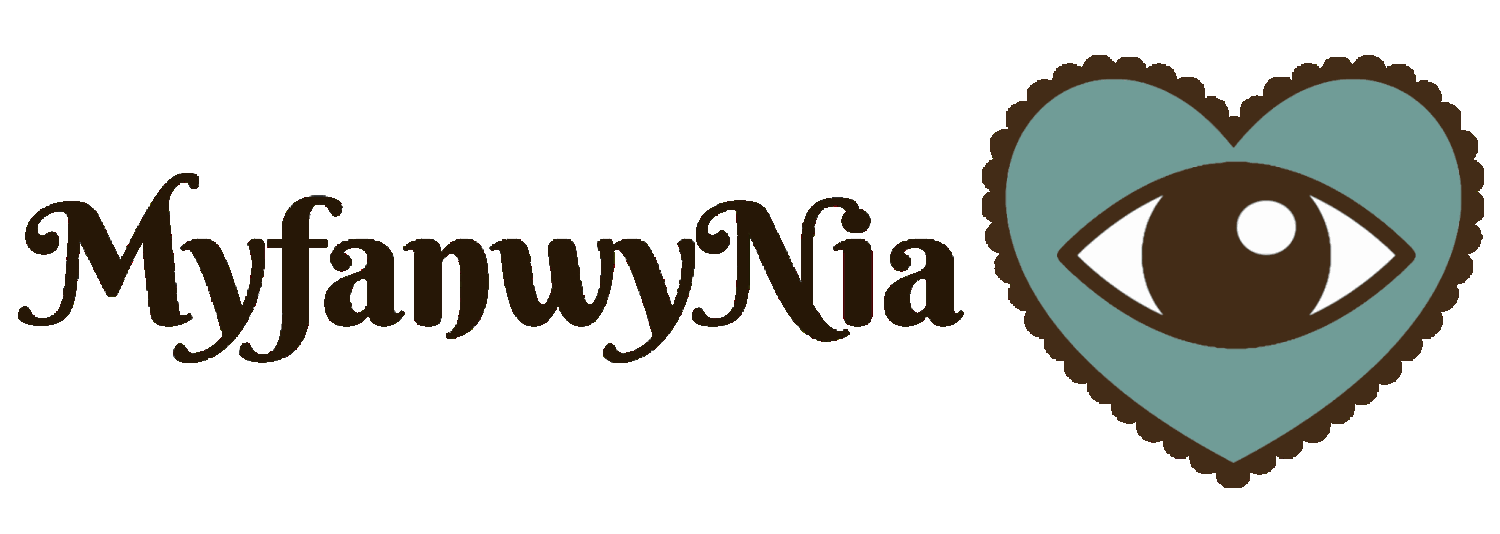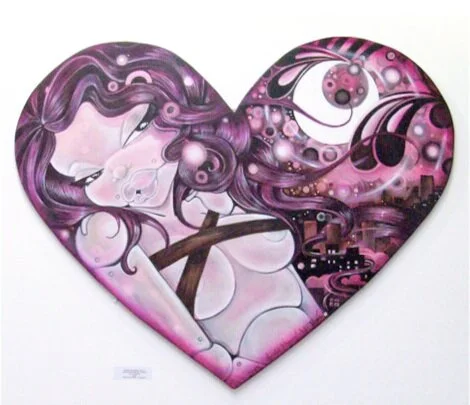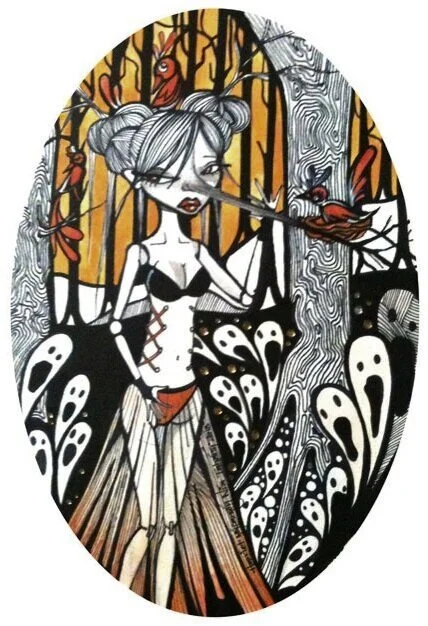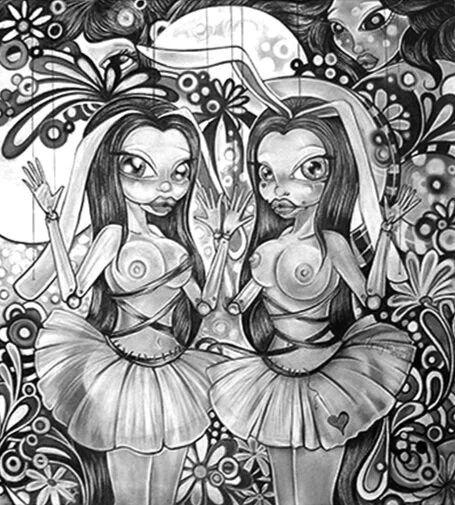

Who Pulls the Strings?
2013 - 2014
This body of work includes paintings and drawings with a Jungian theme, exploring concepts derived from this and an esoteric interpretation of the classic children’s story Pinocchio. Jung believed that, to be psychologically healthy, one must strike a balance between the demands of society and what we really are, in being oblivious to one’s persona he believed that to be underestimating the importance of society, but to be unaware of one’s deep individuality, is to become society’s puppet.
‘Who Pulls The Strings?’ is an exhibition based on this Jungian notion, an exploration of ideas and narratives set in psychedelic dreamscape depicting puppet characters in metaphysical worlds

• Jonah 2013 • Medium: Charcoal, acrylic, glitter and resin on Fabriano stretched over wood. • Status: Sold/Private Collection •
• The Fox & The Puppet Master 2013 • Medium: Charcoal, Glitter, Resin, Oil on Fabriano stretched over wood • Status: Sold/Private Collection •
• The Weight of it All 2013 • Medium: Charcoal on Fabriano • Size: 4 x 5ft • Status: Sold/Private Collection •
• Cosmic Systems 2013 • Medium: Oil on Wood. • Size: 125cm diameter (circular support) • Status: Available •
• Heart Strings 2013 • Medium: Oil on wood. • Size: 3 x 3ft (heart Shaped Support) • Status: Available •
• No Coincidences 2013 • Medium: Charcoal on Fabriano • Size: 3.5 x 5ft • Status: Available •
• Consumption 2013 • Medium: Watercolour and Indian Ink. • Size: 12 x 8 inches • Status: Lost •
• Donkey See Donkey Do 2013 • Medium: Charcoal on Fabriano. • Size: 5 x 5ft • Status: Available •
• The Wishing Star 2013 • Medium: Watercolour and Indian Ink. • Size: 12 x 8 inches • Status: Sold/Private Collection •
• Flight 2013 • Medium: Watercolour and Indian Ink. • Size: 8 x 6 inches • Status: Available •
• Lost 2013 • Medium: Watercolour and Indian Ink. • Size: 12 x 8 inches • Status: Sold/Private Collection •
• The Garden Of Earthly Delights 2013 • Medium: Watercolour and Indian Ink. • Size: 16 x 20 inches • Status: Sold/Private Collection •
• Puppet Eyes 2013 • Medium: Watercolour and Indian Ink. • Size: 12 x 8 inches • Status: Available •
• Spirits 2013 • Medium: Watercolour and Indian Ink. • Size: 12 x 8 inches • Status: Lost •
• The Wishing Star 2013 • Medium: Watercolour and Indian Ink. • Size: 12 x 8 inches • Status: Sold/Private Collection •
• Blue Fairy 2012 • Medium: Watercolour and Indian Ink. • Size: 8 x 6 inches • Status: Sold/Private Collection •

The Exhibition
Harriet’s 2013 – 2014 solo exhibition, ‘Who Pulls The Strings?’ was originally shown at Dublin ‘White Lady Art’ Gallery in Temple Bar then located at 14 Wellington Quay. The opening night was July 6th 2013 the show ran for four weeks until July 27th.
The second showing of ‘Who Pulls The Strings?’ was at Teach Bán – Art Gallery – Drumcliffe, Co. Sligo, in the West of Ireland the exhibition opened on Saturday 12th of April 2014 and ran until the 27th.
Here are some photos from the opening reception at the White Lady Art Gallery in Dublin’s Temple Bar:












































Catalogue Essay:
Who Pull The Strings?
Born 1983 in South Wales, but raised in South East London where she lived until the age of 16. Harriet has since made her home and studio in rural Co. Leitrim, Ireland, where she lives to date.
Harriet’s work is an ongoing exploration of narrative and themes inspired by Jungian story analysis, and mythology. “I am interested in ‘hermeneutics’ the art of literal translation, in attention to characters, events and symbols in a story’s underlying structure”
Harriet’s ideas are often exploring her own spirituality and a personal quest of understanding the metaphysical nature of the universe and its relationship to the psychic and that of the collective psyche that Jung refers to as the collective unconsciousness.
The surrealists of the 1920s were artists that wanted to change the world. Lead by Andre Breton they wrote manifestos claiming a radical shift in political reason could be achieved through art, by the liberation of the imagination as culture was the life affirming glue between people. The surrealists believed that ‘truth’ was to be found in Sigmund Freud’s notions of the murkier recesses of subconscious.
Like the surrealists Harriet is also a truth seeker but believes that Jung’s theories and research far surpass that of Freud. She is interested in a contemporary development of surrealism.
Pop Surrealism, born from consumer culture much like pop art, goes further with elaborate juxtapositions of mass media and pop imagery. Exploring the continued influence of surrealism, as it has been interpreted and expanded by artists who have come of age in an era defined by popular culture. By using people’s preconceptions of pop imagery, then reconfiguring it to convey new surreal ideas.
From amongst these new surreal ideas, Harriet has drawn a notion about the conditioning cultural consciousness of the mass media. By employing its methods through art to aid the wakening of people out of a media saturated mindset. “The world often seems to me as being in a crisis of consciousness, a direct result of cultural conditioning via the television and mass media.” Pop surrealism art is often filled with a humour of modern living in a commodified environment and invokes wonder. Wonder about how far we as a human race will carry on our unsustainable way of living, wonder about what messages we are indoctrinating into the minds of our children and future generations. The carnivalesque qualities in the work of this movement, twisting imagery from the mass media, to us seems surreal because it displaces the expected. The mass media idealized idea of what we should be aspiring to in our lives, beauty, wealth, etc is the norm but is in many ways surreal already twisting reality to depict perfection.
The puppet characters who are all females, are contemplative of this artists own individuality and “dark alluring forces of the vast collective consciousness, that is the Mass Media; filtering into the collective unconsciousness and swaying them from discovering who they really are.” Harriet explains. Harriet’s Characters appear tainted with a sweet yet sinister confusion we sense a feeling they are bound or trapped.
These worlds Harriet creates are non-linear narrative, fragments of stories focusing on the archetypes and symbols the different fragments embody. We see these themes illustrated in Harriet’s new work through depictions of journeys into inner metaphysical worlds, described by decorative psychedelic patterns of circular motifs as the ever shifting of the universal mind. Harriet leaves it up to the viewer to connect the narrative and encourages them to enter into their own imagination when interpreting the stories in a body of work.
Image: Heart Strings 2013, Oil on Wood.
Looking back at Harriet’s previous work such as House of sweets a Hansel and Gretel story and Aladdina and Aladdin story we can glean an understanding of the way Harriet approaches her concepts. Aladdina was a body of work is inspired by the tarot as a way of mapping out your current archetypal path or the current state of your psyche.
Fairy tales have long been thought of like this expounded by Carl Jung’s writings, through the events, characters and symbol within the Stories representing changing aspects of your psyche. Fairy tales being classic archetypes common to all humans often referred to as rites of passage.
Looking back at Harriet’s previous work such as House of sweets a Hansel and Gretel story and Aladdina and Aladdin story we can glean an understanding of the way Harriet approaches her concepts. Aladdina was a body of work is inspired by the tarot as a way of mapping out your current archetypal path or the current state of your psyche. The fairy tales have long been thought of like this expounded by Carl Jung’s writings, through the events, characters and symbol within the Stories representing changing aspects of your psyche. Fairy tales being classic archetypes common to all humans often referred to as rites of passage.
It was Jungian psychoanalyst Clarissa Pinkola Estes book, Woman Who Run with the Wolves, which first lead Harriet to Jung’s theories. This Jungian approach to unlocking the secrets encoded in fairy tales and discovering the wisdom found there, for helping us at different stages of our lives and connecting us back to our true human nature as a wild species. In Estes book she often breaks the stories into tasks for the psyche to complete before coming of round consciousness. Tarot is like these tasks, each card representing some part of this archetypal journey.
Harriet became fascinated by hermeneutics and hidden meaning underpinning stories, breaking them down through focusing on the archetypal structure that the stories embody
In this new body of work we see Harriet expand her artistic depictions of story analysis into the exploration of allegory, a device used widely in histories of all forms of the arts because of its immense power to illustrate complex ideas and concepts in ways that are easily accessible and tangible to an audience.
Harriet has focused on esoteric concepts from Carlo Lorenzini’s classic story of Pinocchio and the more famously adapted version in the 1940’s Disney classic. This story of a wooden puppet that comes to life conceals spiritual allegory with roots in the mystery schools of occultism. Harriet explains further:
“The children’s story about “being good” and “not lying” as allegory becomes the quest for wisdom and spiritual enlightenment. Crammed with timeless and honest social commentaries, Pinocchio depicts a very unsettling vision of our modern world and prescribes, perhaps, a way to escape its traps. Striving to achieve a higher level of spirituality through self-improvement is a very universal theme found in most religions. Pinocchio’s allegory exposes itself as typically Masonic and reveals the philosophical background of those in control of the mass media.”
Pinocchio was originally written by Carlo Lorenzini (known by his pen name, Carlo Collodi) between 1881 and 1883 in Italy. Lorenzini began his writing career in newspapers (Il Lampioneand Il Fanfulla ), where he often used satire to express his political views. In 1875, he entered the world of children’s literature and used this outlet to transmit his political convictions. The series Giannettino, for example, often referred to the unification of Italy.
“Lorenzini became fascinated by the idea of using an amiable, rascally character as a means of expressing his own convictions through allegory. In 1880 he began writing Storia di un burattino (“The story of a marionette”), also called Le Avventure di Pinocchio, which was published weekly in Il Giornale dei Bambini (the first Italian newspaper for children).”
Lorenzini’s work was not solely political. His writings, especially Le Avventure di Pinocchio contained a great deal of metaphysical aspects that are often overlooked by modern readers. One important fact needed to fully understand the depth of Lorenzini’s work is that he was an active Freemason. In an essay called Pinocchio, mio Foretell (Pinocchio, my Brother) Italian Freemason Giovanni Alveoli describes the Masonic background of Lorenzini:
“Carlo Collodi’s initiation into Freemasonry, even if cannot be found in any official records, is universally recognized and often referred to. Aldo Mola, a non-mason who is generally defined as an official historian of Freemasonry, has expressed with great certitude the writer’s initiation into the Masonic family. Events in Collodi’s life seem to further confirm this thesis: the creation in 1848 of a paper called “Il Lampione” (The Beacon), which, as stated by Lorenzini, “illuminated all who were teetering in darkness”; he also considered himself a “passionate disciple of Mazzini” (a prominent Italian Freemason and revolutionary).”
Geppetto has created puppet, but he realizes that he needs the help of the “Greater God” to give Pinocchio the divine spark needed in order to become a “real boy” or, in esoteric terms, an illuminated man. So he “wishes upon a star”. He asks the Greater God (the Great Architect of the Masons) to infuse Pinocchio with some of its divine essence.
In Harriet’s painting ‘The Wising Star’ we see a spill of a common motif in Harriet’s work a heart with an eye representing love and awareness pouring out of a puppet character towards a blue star. Could this star be Sirius, the Blazing Star of Freemasonry?
The “Blue Fairy”, the representative of the Great God, then descends to earth to give Pinocchio a spark of the Universal Mind, the “Nous” of the Gnostics.
Image: The Wishing Star 2013, Watercolour and Indian Ink.
The “Blue Fairy”, the representative of the Great God, then descends to earth to give Pinocchio a spark of the Universal Mind, the “Nous” of the Gnostics.
The Fairy confers to Pinocchio the gift of life and free will. Although he is alive, he is not a yet a “real boy”. Mystery schools teach that real life only starts after illumination.
When Pinocchio asks “Am I a real boy?“, the Fairy replies “No, Pinocchio. To make Geppetto’s wish come true will be entirely up to you. Prove yourself brave, truthful and unselfish and someday you will be a real boy“.
This theme of self-reliance and self-improvement is strongly inspired by Gnostic/Masonic teachings: spiritual salvation is something that has to be deserved through self-discipline, self-knowledge and intense will power.
Image:
Blue Fairy 2012, Watercolour on paper.
On his way to school, Pinocchio is stopped by Foul-Fellow the Fox and Gideon the Cat who lure him to the ”easy road to success”: show business. Despite his conscience’s warnings, the puppet follows the shady characters and is sold to Stromboli, the puppet master.
During his performance, Pinocchio is acquainted with the up sides of the “easy road”: fame, Pinocchio however quickly learns the great costs of this apparent success: he cannot go back to see his father (the Creator), the money he generates is only used to enrich Stromboli and Pinocchio talents are being exploited and used for a will that is not of his own truth.
In Harriet’s piece ‘The Fox and The Puppet Master’ we see a representation of this archetype of ‘ the temptation of fame and fortune’ as a news reporter controlling a puppet character while at the same time reporting about it, this scene includes Masonic symbols of a king Solomon’s temple entrance. We are distracted by the animated fox and the enlightenment the temple represents is pushed back.
Image: The Fox & The Puppet Master 2013, charcoal, resin & oil on stretched Fabriano over wood.
Pinocchio realizes the sad state he is in. He is caged up like an animal and at the mercy of a cruel puppeteer. He was duped into selling his soul.
Feeling lost he lies to the fairy and himself. This idea of not confronting your problems is expressed in Harriet’s painting lost.
Image:
Lost 2013, Watercolour and Indian Ink.
Back on the right path, Pinocchio is stopped again by Foul fellow the Fox who lures him into going to “Pleasure Island”, a place with no school (knowledge) and laws (morals). Kids can eat, drink, smoke, fight and destroy at will, all under the watchful eye of The Coachman.
Pleasure Island is a metaphor for the “profane life” characterized by ignorance, the search for instant gratification and the satisfaction of the one’s lowest impulses. The coachman encourages this behaviour knowing it is a perfect method to create slaves. The boys who indulge enough into this dumbed-down lifestyle turn into donkeys or jack asses who are then exploited by The Coachman to work in a mine. Another rather grim depiction, this time of the ignorant masses.
Pinocchio returns home to his father but the house is empty. He learns that Geppetto has been swallowed by a giant whale. The puppet then jumps into water himself and gets swallowed by the whale in order to find his Creator. This is his final initiation, where he has to escape the darkness of the ignorant life (symbolized by the womb of the giant whale) and gain spiritual light.
Image:
Donkey See Donkey Do 2013, Charcoal on Fabriano.
Once again, Carlo Collodi was heavily inspired by a classic story of spiritual Initiation: the Book of Jonah. Found in Christianity, Islam and Judaism, Jonah and the Whale is also read in Mystery schools.
Manly P. Hall explains here the occult meaning of the Jonah and the Whale.
“When used as a symbol of evil, the fish represented the earth (man’s lower nature) and the tomb (the sepulcher of the Mysteries). Thus was Jonah three days in the belly of the “great fish,” as Christ was three days in the tomb. Several early church fathers believed that the “whale” which swallowed Jonah was the symbol of God the Father, who, when the hapless prophet was thrown overboard, accepted Jonah into His own nature until a place of safety was reached. The story of Jonah is really a legend of initiation into the Mysteries, and the “great fish” represents the darkness of ignorance which engulfs man when he is thrown over the side of the ship (is born) into the sea (life).”
– Manly P. Hall, The Secret Teachings of All Ages
Image:
Jonah 2013, acrylic, glitter and resin on fabriano stretched over wood.
Pinocchio went through the hardships of initiation and came out of the darkness of ignorance. He emerges from tomb resurrected, like Jesus Christ. He is now a “real boy”, an illuminated man who broke the shackles of material life to embrace his higher self.
Jung believed that, to be psychologically healthy, one must strike a balance between the demands of society and what we really are, in being oblivious to one’s persona he believed that to be underestimating the importance of society, but to be unaware of one’s deep individuality, is to become society’s puppet.
Alexa Mac Dermot (Curator & Director at ‘White Lady Art’, Dublin)
Harriet Myfanwy Nia Tahany
Original Press Release:
White Lady Art presents
Harriet Myfanwy Nia Tahany
Who Pulls The Strings?
‘White Lady Art’ in Dublin’s Temple Bar area, located at 14 Wellington Quay will be presenting a new exhibition by Irish Pop Surrealist – Harriet Myfanwy Nia Tahany, from July 4th – 27th 2013.
Harriet is a recipient of the RDS Taylor award, graduated from the University of Ulster in 2009 with a Masters in Fine Art. Harriet has exhibited in Belfast and Sligo, this will be her eighth solo exhibition and second solo in Dublin. This new body of work includes paintings and drawings with a Jungian theme, exploring concepts derived from this and an esoteric interpretation of the classic children’s story Pinocchio.
Jung believed that, to be psychologically healthy, one must strike a balance between the demands of society and what we really are, in being oblivious to one’s persona he believed that to be underestimating the importance of society, but to be unaware of one’s deep individuality, is to become society’s puppet.
‘Who Pulls The Strings?’ is an exhibition based on this Jungian notion, an exploration of ideas and narratives set in a psychedelic dreamscape depiction of puppet characters in a metaphysical world.
Harriet is well known for her ongoing exploration of themes inspired by ‘hermeneutics’, the art of literal translation, in attention to characters, events and symbols in a story’s underlying structure, often with a particular emphasis on fairytales and mythology. In this new body of work we see Harriet expand her artistic depictions of story analysis into the exploration of allegory, a device used widely in histories of all forms of the arts because of its immense power to illustrate complex ideas and concepts in ways that are easily accessible and tangible to an audience.
Harriet has focused on esoteric concepts from Carlo Lorenzini’s classic story of Pinocchio and the more famously adapted version in the 1940’s Disney classic. This story of a wooden puppet that comes to life conceals spiritual allegory with roots in the mystery schools of occultism. Harriet explains further:
“The children’s story about “being good” and ”not lying” as allegory becomes the quest for wisdom and spiritual enlightenment. Crammed with timeless and honest social commentaries, Pinocchio depicts a very unsettling vision of our modern world and prescribes, perhaps, a way to escape its traps. Striving to achieve a higher level of spirituality through self-improvement is a very universal theme found in most religions. Pinocchio’s allegory exposes itself as typically Masonic and reveals the philosophical background of those in control of the mass media.”
We see these themes illustrated in Harriet’s new work through depictions of journeys into inner metaphysical worlds, described by decorative psychedelic patterns of circular motifs.
The puppet characters who are all females, are contemplative of this artists own individuality and “dark alluring forces of the vast collective consciousness, that is the Mass Media; filtering into the collective unconsciousness and swaying them from discovering who they really are.” They appear tainted with a sweet yet sinister confusion, through the unsettling juxtaposition of imagery stylistically inspired by “popular culture and contemporary children’s toys metaphysically forming the invisible strings that control them.”


























